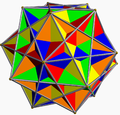| Compound of five cubes | |
|---|---|
 (Animation, 3D model) | |
| Type | Regular compound |
| Coxeter symbol | 2{5,3}[5{4,3}] [1] [2] |
| Stellation core | rhombic triacontahedron |
| Convex hull | Dodecahedron |
| Index | UC9 |
| Polyhedra | 5 cubes |
| Faces | 30 squares (visible as 360 triangles) |
| Edges | 60 |
| Vertices | 20 |
| Dual | Compound of five octahedra |
| Symmetry group | icosahedral (Ih) |
| Subgroup restricting to one constituent | pyritohedral (Th) |


The compound of five cubes is one of the five regular polyhedral compounds. It was first described by Edmund Hess in 1876.
Contents
Its vertices are those of a regular dodecahedron. Its edges form pentagrams, which are the stellations of the pentagonal faces of the dodecahedron.
It is one of the stellations of the rhombic triacontahedron. Its dual is the compound of five octahedra. It has icosahedral symmetry (Ih).
The compound of five cubes can also be known as a rhombihedron.












